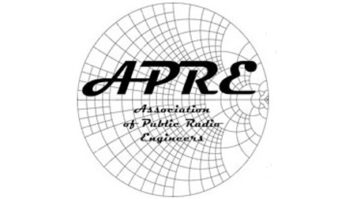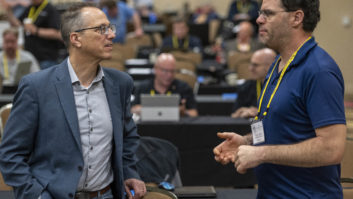Colorado Public Radio Goes Surround
Mar 1, 2008 12:00 PM, By Jim Paluzzi, CBT
Many of my colleagues have been predicting that surround sound will be the killer app for audio by the end of this decade. I, too, anticipate a 5.1 future that will provide the opportunity to augment and extend the listening experience for radio listeners. At the same time, however, this opportunity presents us with a huge challenge as many of our listeners are avid concert-goers that have heard firsthand many of the current world-class orchestras playing in acoustically optimized settings.
When I began evaluating surround technology, I had a number of mandates to fulfill as the technology specialist for CPRN, and its flagship stations, KVOD-FM Denver, and KUSC-FM Los Angeles. CPRN provides 24-hour broadcast programming and Internet streaming for its 60 public radio station network, as well as HD Radio programming distributed through NPR.

David Rutherford, one of the hosts for the Classical Public Radio Network, in the studio.
My first mandate for KVOD and the other CPRN members was finding a surround technology that would seamlessly work with everyone’s existing stereo facilities. As public radio stations, our members were faced with major budget constraints that could not justify a complete re-tooling of their audio chain to accommodate separate surround audio channels.
Mandate number two required that the technology bridge the analog and digital worlds, but not be obsolete when the digital transition is completed. That also meant the technology would need to handle not only digital terrestrial broadcasts, but also digital Internet streaming.
Mandate number three, the most important of all, demanded that the 5.1 technology be easy to use and implement. The new technology had to provide our discriminating listeners with the best classical music experience, no matter what type of radio receiver. In short, our 5.1 implementation had to sound great on a conventional car radio, a home stereo system or a mono clock radio � as well as providing a solid surround sound experience for listeners using 5.1 receivers.
Getting started
We began extensive search of the marketplace, and found a number of products that covered perhaps one or two of the mandates, but not all of them. In the end, we selected Neural Audio and their Neural-THX Surround technology � because its downmix technology satisfied all our requirements.

The satellite receivers can be set to delay the programming as needed to delay the program feed for each time zone. The upper receiver here is set for a two-hour delay.
I had heard great things about the downmix approach to combining 5.1 and stereo from Don Danko, vice president for engineering at WGUC-FM in Cincinnati. Danko said Neural’s downmix had worked well with the station’s existing stereo infrastructure when it had initiated surround sound broadcasting.
Danko had successfully tested the ability of the Neural-THX Surround Downmix system to transport 5.1 through a stereo infrastructure, because traditional stereo and 5.1 content are basically two dimensional, with both width and depth spatial attributes. The Downmix systems work by correcting overlaps of intensity, time, coherence, polarity and phase of the signal sources, allowing surround channels to be combined or watermarked into a stereo downmix for broadcast or storage.
Similarly, the Neural-THX Surround Upmix system takes the stereo two-channel content and renders it into stereo, matrix-encoded stereo, or digital and analog surround. For listeners with a Neural-THX Surround enabled receiver, individual content elements are positioned exactly where they should be heard in the listening field for an exceptional surround experience.
Neural Audio had taken the initiative in expediting the creation of surround content for CPRN by encoding nearly 1,600, 5.1 classical musical pieces. Neural contacted the major players in the classical music distribution system, Telarc and Deutsche Grammophone, for permission to encode their available 5.1 content for stereo. By taking this approach, Neural was able to provide CPRN with downmixed content on a hard drive that accurately represented the original musical pieces � a great start for our transition to 5.1 broadcasting.
Steve Coghill, CPRN director of operations and program planning, heard his first Neural 5.1 recording at work through his computer and office stereo system. Because it is not a 5.1 system, he did not have the full surround sound experience. However, he has noticed a great deal of definition and clarity in the recordings.
After we received the Neural external hard drive, Coghill began to work on reviewing and classifying the content for our music scheduling system. He found Neural’s cart chunk data feature was very helpful in identifying each file.
Easy going
Because the Neural content was downmixed into two-channel audio, no accommodations had to be made to the material for CPRN’s Prophet Systems Nexgen (now RCS) automation system. We were able to integrate the new surround material into the Prophet system, just as we would have any other recorded musical content. Once again, the huge advantage of Neural-THX Surround 5.1 system is that the downmixed, surround audio simply travels over any existing two-channel system.

Because surround material is encoded to a stereo file, the facility infrastructure including the Nexgen automation system required no special accommodations.
Not too long after the evaluation process was completed, I began relating our findings to Scott Henderson, CPRN’s executive director. I told Henderson that Neural worked flawlessly with our stereo audio chain without any facility upgrades. He was initially skeptical, so I set up a listening demonstration, including samples of a recent performance of the Colorado Symphony Orchestra that Martin Skavish, Colorado Public Radio’s recording engineer, had produced for live broadcast. After just one listening session, Henderson was a believer.
For the CPRN network, 5.1 programming is assembled at Colorado Public Radio’s facilities in Denver, incorporating our hosts and producers in Los Angeles, Denver and Minneapolis. The program service is uplinked via satellite to CPRN’s affiliate stations throughout the country. Each affiliate station has an International Communication Products satellite receiver equipped with a circular buffer system that can delay the audio internally by 0, 1, 2 or 3 hours, so the content is properly day-parted for each time zone. This approach allows announcers to give time checks in real time (like 8:17), instead of having to say, �It’s 17 minutes past the hour.�
As are part of the CPRN network, Colorado Public Radio carries CPRN programming for 23 out of 24 hours of the day. We receive our audio from a satellite receiver � just like all of the other CPRN affiliates.
We are definitely sold on Neural-THX Surround. We think that our listeners will also be sold by the exceptional surround sound experience that the technology will bring to their homes and offices.
Paluzzi is VP of new media and technology, Colorado Public Radio, Denver.











